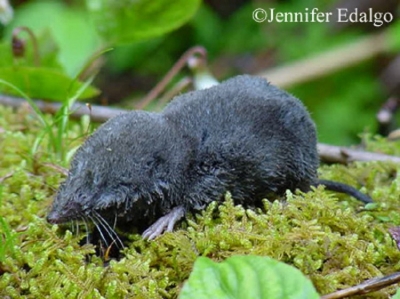Northern Short-tailed Shrew , Blarina brevicauda
The Northern Short-tailed Shrew is the largest shrew and one of the most common mammals, in North America; it occurs in middle and eastern Tennessee.
Description:
A very small mammal with a pointed snout, tiny eyes, cylindrical body, concealed ears, and short, slender legs. The soft fur is uniformly slate gray, but slightly lighter on the belly, feet, around the mouth and under the tail. The tail has fur and is distinctly short.
Length: 3.7 - 5.0 inches
Tail: 0.7 - 1.0 inches
Weight: 0.5 - 1.0 ounces
Similar Species:
•Eastern Mole is much larger and has forelimbs adapted for digging.
•Cinereus Shrew and Southeastern Shrew are more brownish in color and have longer tails.
•Least Shrew is smaller and dark brown.
•The Southern Short-tailed Shrew is smaller, but can often not be separated from the Northern Short-tailed Shrew without detailed analysis of skull and dental formations, and possibly an expert.
Habitat:
The Northern Short-tailed Shrew occurs in a variety of habitats including woodlands, grasslands, brushlands, field edges and marshy areas. They can often be found living in thick, weedy growth, under mossy banks, under old logs and under the humus layer on a forest floor.
Diet:
Primarily eats spiders, centipedes, snails, earthworms and insect larvae, but occasionally eats salamanders, snakes, birds and mice. Also, eats some plant foods.
Breeding information:
The breeding season peaks in the spring and fall, but may occur any time of year. Females usually have one or two litters per year. Nests made of shredded grass or leaves are placed in tunnels or under logs or rocks. Litters of 3-10 (usually 5-7) young are born after a 21-22 day gestation period. The young are naked, wrinkled and dark pink at birth. Weaning takes place after about 25 days.
Status in Tennessee: No conservation concerns as they may be common in suitable habitat.
Fun Facts:
• As with other shrews the Northern Short-tailed Shrew is a voracious eater and consumes half its body weight in food per day and significantly more in the winter months.
Best places to see in Tennessee: Moist woodlands.
